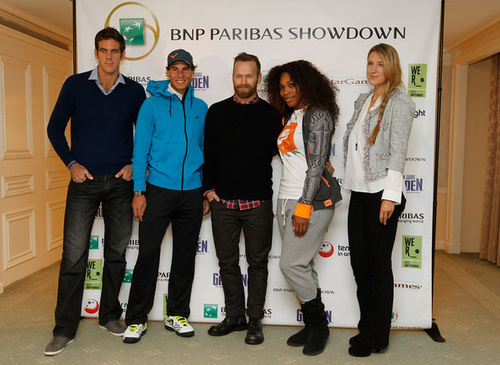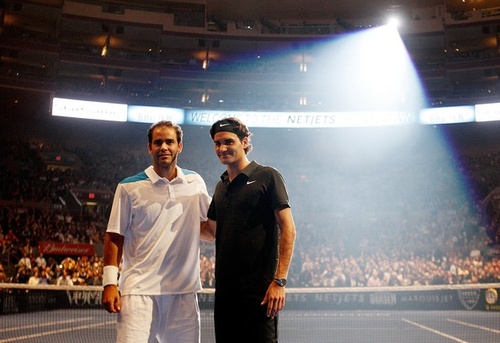Don't miss any stories → Follow Tennis View
FollowPoint, Counterpoint: The Case For And Against Exhibitions
As 2013 winds down to a close, people around the world take stock of the year that has been. The sport of tennis is no different. Lists detailing the best and worst matches of the season, the surprises, and the duds begin to surface as pundits look to see what can be gleaned from this information and what it may translate into in 2014. But amidst all of the various lists, there is also one type of event that tends to garner much attention this time of year: the exhibition.

As a general rule, exhibitions provide more positives than negatives. In fact, it was through various series of exhibitions that guys like Hall of Famers Jack Kramer and Richard “Pancho” Gonzalez helped to lay the foundation for today’s professional tour. That is because exhibitions have continuously proven themselves valuable catalysts for generating interest in the game. Logistically, they are organized on a much smaller scale than a full-blown tournament, meaning that they can be staged in the most remote corners of the globe almost as easily as in a bustling metropolis. This affords exhibition organizers the opportunity to bring tennis and its star players to audiences not fortunate enough to be within easy traveling distance to a professional tournament, which means potential growth in both fans and players at a grassroots level.
Aside from the promise of some entertaining tennis, another reason for why exhibitions are such a draw is that they also provide an excellent atmosphere for showcasing the personalities of some of the biggest names in the game. Most players exhibit very little of their personality while on the match court. Some may occasionally vent their frustration or express their anger, while others seem virtually void of emotion. But put some of those same players on an exhibition court, and they can become anything from the most endearing competitor to have ever picked up a racquet to a regular comedian.
Exhibitions also provide for some very candid moments, some of which were among the highlights of the 2013 season. Serena Williams took it all in stride when Redfoo stood in for Victoria Azarenka in their exhibition match at Madison Square Garden in March. Later at the same event, Juan Martin Del Potro took a victory lap with his young stand-in doubles partner, who had the crowd in stitches after she proved herself more than capable of dishing it out to Rafael Nadal’s impromptu partner, Ben Stiller. And nobody could forget the charity exhibition match at the Queen’s Club event in London, when Andy Murray clocked his current coach and former major champion Ivan Lendl, after which he proceeded to celebrate and play to the crowd more than he had in the entirety of his professional career.
But exhibitions do not draw the line at showcasing only the game’s current crop of headliners. They also provide the unique opportunity to mix generations and pit them against one another. A prime example of this can be seen in the trio of exhibitions contested in Asia in 2007 between Pete Sampras and Roger Federer. Federer and Sampras are unquestionably two of the greatest legends in tennis history, and their brief exhibition series built upon interest in tennis in Asia. Also, since players never really push themselves to maximum capacity, an exhibition match evens the playing field between the multiple generations contesting it, allowing for plenty of engaging rallies.

For all of the positives that exhibitions bring, however, those played between the end of November through December can bring a few negatives. As has been noted ad nauseam, the tennis offseason is too short, especially when compared to a number of other major sports. Players need to take advantage of the brief respite to mentally and physically refresh themselves before going on to prep for the upcoming season. Despite the fact that those November and December exhibitions are not nearly as physically and mentally taxing as competitive tournament matches, they still represent time on the court with a racquet in hand. In many cases, they also mean a shift in time zones and miles on a plane, all of which cuts into a player’s all-too-short offseason.
Exhibitions contested in the offseason also provide ammunition for tournament directors whenever talks arise concerning scheduling. Players have the right to dictate what they do in their free time, and it is generous of them to give up portions of their offseason to participate in exhibitions. Players also have a right to the lucrative appearance fees they are given when they play such events, for they are after all the ones who sell tickets. But from a tournament director’s standpoint, it is easy to see where these offseason exhibitions would cause reluctance to give ground to the players when it comes to scheduling.
Many of the smaller tournaments cannot afford the appearance fee payouts that players receive at some of these exhibitions. Furthermore, if a player who complains about the number of weeks on the current tour calendar then goes on to play an exhibition in the offseason, it is only natural that a tournament director would question why he or she should be asked to give up their spot on the calendar, or worse, see their tournament wiped off the calendar altogether if players are not taking full advantage of the offseason as is. There is likely a fear that shortening the calendar would also just translate into more exhibition and appearance fee opportunities for the players at a tournament’s expense. These sentiments all add to the vicious cycle of dead-end dialogue between players and tournament directors when it comes to scheduling.
Despite this handful of negatives, however, it is evident that the positives reaped from exhibitions mean that they should continue, irrespective of when they are played. Still, down the road, it would be wise if scheduling could be done in a way that would allow for exhibitions to occur within the confines of the regular season. Perhaps a compromise might be reached where tournament directors would even consider an exhibition in place of a tournament. There is clearly a place for exhibitions within the current landscape of the game, so thought should be given to how they can be used to an even greater potential.










